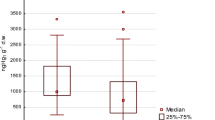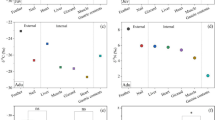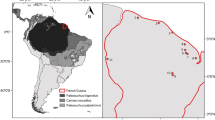Abstract
Goosanders (Mergus merganser, ad, adult n = 42: M, males 33 and F, females 9; im, immature n = 17: M 8, F 9) were collected in 2005 at wintering site in the River Odra estuary (Poland). The body size (BM, body mass; BL, body length; KL, keel length), weights of organs (LM, liver; KM, kidneys; EM, encephalon), and two condition-related indices (BM/BL and BM/KL) were determined. Based on BM/BL and BM/KL indices, the birds were divided into 3 condition groups: A (very good), B (good), and C (moderate). Total mercury (Hg) concentrations (mg kg−1 dry weight) were determined in liver, kidney, brain, breast muscle, and bone of 17 birds (ad, n = 8: 8 M, 1 F; im, n = 9: 6 M, 3 F). The highest Hg concentrations (in n = 17) were recorded in liver and kidney (14.7 and 9.9 mg kg−1, respectively); the concentrations found in muscle and brain were lower (2.3 and 1.3 mg kg−1, respectively), the lowest concentrations being typical of bone (0.08 mg kg−1). Mercury concentrations in the same organs of immature and adult goosanders, as well as males and females, did not differ significantly. On the other hand, distinct differences in Hg concentrations in the organs studied (except for the liver) were observed between individuals assigned to Group A (n = 11) and C (n = 6). Mercury levels were higher in the birds characterised by very good condition, which was most probably related to those birds being more efficient hunters, consuming higher amounts of Hg-containing fish. Significant and negative correlations between the muscle Hg concentration and the two condition-related indices (r > –0.70) were recorded in Group A only: the higher the concentration, the lower the BM/LM and BM/KL values.



Similar content being viewed by others
References
Agusa T, Matsumoto T, Ikeoto T, Anan Y, Kubota R, Yasunaga G, Kunito T, Tanabe S, Ogi H, Shibata Y (2005) Body distribution of trace elements in black-tailed gulls from Rishiri Island, Japan: Age-dependent accumulation and transfer to feathers and eggs. Environ Toxicol Chem 24:2107–2120
Arctic Monitoring and Assessment Programme/United Nations Environment Programme (2008) Technical background report to the global atmospheric mercury assessment. Arctic Monitoring and Assessment Programme/UNEP Chemicals Branch, pp 159
Austin JE, Fredrickson LH (1987) Body and organ mass and body composition of postbreeding female lesser scaup. Auk 104:694–699
Badzinski SS, Flint PL, Gorman KB, Petrie SA (2009) Relationships between hepatic trace element concentrations, reproductive status, and body condition of female greater scaup. Environ Pollut 157:1886–1893
Bagge P (1975) Pesticide residues in some Baltic animals. A review of selected literature. Pure Appl Chem 42:129–137
Bennett DC, Hughes MR (2003) Comparison of renal and salt gland function in three species of wild ducks. J Exp Biol 206:3273–3284
Bird Directive (1979) Council directive 79/409/EEC
Birdlife International (2007) Species factsheet: Mergus merganser (www.birdlife.org. Accessed 3 Dec 2007)
Boening DW (2000) Ecological effects, transport, and fate of mercury: a general review. Chemosphere 40:1335–1351
Bojakowska I, Gliwicz T, Małecka K (2006) The results of geochemical studies on the water sediments in Poland in years 2003–2005. Bibl Monit Środ, Warszawa [in Polish], pp 116
Borg K, Erne K, Hanko E, Wanntorp H (1970) Experimental secondary methyl mercury poisoning in the goshawk (Accipiter G. gentilis L.). Environ Pollut 1:91–104
Braune BM, Malone BJ (2006) Organochlorines and mercury in waterfowl harvested in Canada. Environ Monit Assess 114:331–359
Braune BM, Malone BJ, Burgess NM, Elliott JE, Garrity N, Hawkings J, Hines J, Marshall H, Marshall WK, Rodrigue J, Wakeford B, Wayland M, Weseloh DV, Whitehead PE (1999) Chemical residues in waterfowl and gamebirds harvested in Canada, 1987–1995. Canadian Wildlife Service Technical Report Series No 326, Ottawa, pp 443
Burger J, Gochfeld M (1997) Risk, mercury levels and bird: relating adverse laboratory effects to field biomonitoring. Environ Res 75:160–172
Champoux L, Rodrigue J, Braune B, Leclair D (1999) Contaminants in Northern Québec wildlife. In: Jensen J (ed) Synopsis of research conducted under the 1997–1998 Northern Contaminants Program. Department of Indian Affairs and Northern Development, Ottawa, Canada, pp 109–116
Champoux L, Masse DC, Evers D, Lane OP, Plante M, Timmermans STA (2006) Assessment of mercury exposure and potential effects on common loons (Gavia immer) in Québec. Hydrobiologia 567:263–274
Daoust P-Y, Conboy G, McBurney S, Burgess N (1998) Interactive mortality factors in common loons from maritime Canada. J Wildl Dis 34:524–553
Debacker V, Holsbeek L, Tapia G, Gobert S, Joiris CR, Jauniaux T, Coignoul F, Bouquegneau JM (1997) Ecotoxicological and pathological studies of common guillemots Uria aalge beached on the Belgian coast during six successive wintering periods (1989–90 to 1994–95). Dis Aquat Org 29:159–168
DesGranges J-L, Rodrigue J, Tardif B, Laperle M (1998) Mercury accumulation and biomagnification in ospreys (Pandion haliaetus) in the James Bay and Hudson Bay regions of Québec. Arch Environ Contam Toxicol 35:330–341
Drobney RD (1984) Effect of diet on visceral morphology of breeding wood ducks. Auk 101:93–98
Duchesne JF, Lévesque BB, Gauvin D, Braune B, Gingras S, Dewailly E (2004) Estimating the mercury exposure dose in a population of migratory bird hunters in the St. Lawrence River region, Québec, Canada. Environ Res 95:207–214
Dzubin A, Cooch E (1992) Measurements of geese field methods. California Waterfowl Assoc, Sacramento, p 20
Eagles-Smith CA, Ackerman JT, Yee J, Adelsbach TL (2009) Mercury demethylation in waterbird livers: dose-response thresholds add differences among species. Environ Toxicol Chem 28:568–577
Eisler R (1987) Mercury hazards to fish, wildlife, and invertebrates: a synoptic review. U.S. Fish and Wildlife Service Biological Report 85 (1.10)
Elbert RA, Anderson DW (1998) Mercury levels, reproduction, and hematology in western grebes from three California lakes, USA. Environ Toxicol Chem 17:210–213
Evers D, Burgess NM, Champoux L, Hoskins B, Major A, Goodale WM, Taylor RJ, Poppenga R, Daigle T (2005) Patterns and interpretation of mercury exposure in freshwater avian communities in Northeastern North America. Ecotoxicology 14:193–221
Falandysz J, Chwir A, Wyrzykowska B (2000) Total mercury contamination of some fish species in the firth of Vistula: a river and the lower Vistula River, Poland. Pol J Environ Stud 99:335–339
Fournier F, Karasov WH, Kenow KP, Meyer MW, Hines RK (2002) The oral bioavailability and toxicokinetics of methylmercury in common loon (Gavia immer) chicks. Comp Bioch Physiol A 133:703–714
Frank R, Lumsden H, Barr JF, Braun HE (1983) Residues of organochlorine insecticides, industrial chemicals and mercury in eggs and in tissues taken from healthy and emaciated common loons, Ontario, Canada, 1968–1980. Arch Environ Contam Toxicol 12:641–654
Freeman S, Jackson WM (1990) Univariate metrics are not adequate to measure avian body size. Auk 107:69–74
Gammonley JH, Heitmeyer ME (1990) Behavior, body condition, and foods of buffleheads and lesser scaups during spring migration through the Klamath Basin, California. Wilson Bull 102:672–683
Gerstenberger SL (2004) Mercury concentrations in migratory waterfowl harvested from Southern Nevada Wildlife Management areas, USA. Environ Toxicol 19:35–44
Glasby GP, Szefer P, Geldon J, Warzocha J (2004) Heavy-metal pollution of sediments from Szczecin Lagoon and the Gdansk Basin, Poland. Sci Total Environ 330:249–269
Häkkinen I, Häsänen E (1980) Mercury in eggs and nestlings of the osprey (Pandion haliaetus) in Finland and its bioaccumulation from fish. Ann Zool Fennici 17:131–139
Heinz GH (1979) Methylmercury: reproductive and behavioral effects on three generations of mallard ducks. J Wildl Manage 43:394–401
Heinz GH (1996) Mercury poisoning in wildlife. In: Faibrother A, Locke LN, Hoff GL (eds) Non-infectious diseases of wildlife. Iowa State University Press, Ames, Iowa, pp 118–127
Heinz GH, Locke LN (1976) Brain lesions in mallard ducklings from parents fed methylmercury. Avian Dis 20:9–17
Heinz GH, Hoffman DJ, Klimstra JD, Stebbins KR, Kondrad SL, Erwin CA (2009) Species differences in the sensitivity of avian embryos to methylmercury. Arch Environ Contam Toxicol 56:129–138
HELCOM (2007) Baltic Sea environment proceedings No. 108. Heavy metal pollution to the Baltic Sea in 2004. Baltic Marine Environment Protection Commission
HELCOM (2004) Baltic Sea environment proceedings No. 93. The fourth Baltic Sea pollution load compilation (PLC-4). Baltic Marine Environment Protection Commission
Hoffman DJ, Ohlendorf HM, Marn CM, Pendelton GW (1998) Association of mercury and selenium with altered glutathione metabolism and oxidative stress in diving ducks from the San Francisco bay region, USA. Environ Toxicol Chem 17:167–172
Hopkins WA, Hopkins LB, Unrine JM, Snodgrass J, Elliot JD (2007) Mercury concentration in tissues of osprey from the Carolinas, USA. J Wildl Manag 71:1819–1829
Houserovà P, Kubàň V, Kràčmar S, Sitko J (2007) Total mercury and mercury species in birds and fish in a aquatic ecosystem in the Czech Republic. Environ Pollut 145:185–194
Jagoe CH, Bryan AL, Brant HA, Murphy TM, Brisbin IL (2002) Mercury in bald eagle nestlings from South Carolina, USA. J Wildl Dis 38:706–712
Kalisińska E (2005) Anseriform brain and its parts versus taxonomic and ecological categories. Brain Behav Evol 65:244–261
Kalisińska E, Dańczak A, Pierko M, Wysocki D (1999) Relationships between kidney weight and body size in some Anseriformes. Anat Histol Embryol 28:55–59
Karasov WH, Kenow KP, Meyer W, Fournier F (2007) Bioenergetic and pharmacokinetic model for exposure of common loon (Gavia immer) chicks to methylmercury. Environ Toxicol Chem 26:677–685
Kenntner N, Tataruch F, Krone O (2001) Heavy metals in soft tissue of white-tailed eagles found dead or moribund in Germany and Austria from 1993 to 2000. Environ Toxicol Chem 20:1831–1837
Kenntner N, Oehme G, Heidecke D, Tataruch F (2004) Retrospektive Untersuchung zur Bleiintoxikation und Exposition mit potenziell toxischen Schwermetallen von Seeadlern Haliaeetus albicilla in Deutschland. Vogelwelt 125:63–75
Kenow KP, Meyer MW, Hines RK, Karasov WH (2007) Distribution and accumulation of mercury in tissues of captive-reared common loon (Gavia immer) chicks. Environ Toxicol Chem 26:1047–1055
Koivusaari J (1976) Chlorinated hydrocarbons and total mercury in the prey of the white-tailed eagle (Haliaeetus albicilla L.) in the Quarken Straits of the Gulf of Bothnia, Finland. Bull Environ Contam Toxicol 15:235–241
Langlois C, Langis R (1995) Presence of airborn contaminants in the wildlife of northern Québec. Sci Total Environ 160(161):391–402
Ławicki Ł, Czeraszkiewicz R, Guentzel S, Jasiński M, Kajzer Z, Kaliciuk K, Oleksiak A (2008) Wintering of waterbirds in Western Pomerania in 2002–2008 [in Polish, English Summary]. Not Ornit 49:235–244
Madge S, Burn H (1988) Wildfowl: an identification guide to the ducks, geese and swans of the world. Christopher Helm, London, p 298
MDMP (2007) The Madison declaration on mercury pollution. Ambio 36:62–65
Mohr A, Górski W, Wiatr B (2007) Mergus merganser. In: Sikora A, Rohde Z, Gromadzki M, Neubauer G, Chylarecki P (eds) The Atlas of Breeding Birds in Poland 1985–2004. Bogucki Wydawnictwo Naukowe, Poznan, pp 86–87
Monteiro LR, Furness RW (2001) Kinetics, dose–response, and excretion of methylmercury in free-living adult Cory’s Shearwaters. Environ Sci Technol 35:739–746
Munns WR (2006) Assessing risks to wildlife populations from multiple stressors: overview of the problem and research needs. Ecol Society 11: 23 (http://www.ecologyandsociety.org)
EC No 1881/2006 (2006) Commission regulation (EC) No 1881/2006 of 19 December 2006 setting maximum levels of certain contaminants in foodstuffs
Nocera JJ, Taylor PD (1998) In situ behavioral response of common loons associated with elevated mercury (Hg) exposure. Conser Ecol 2:10 (http://www.consecol.org/vol2/iss2/art10/)
OJC (2006) Community strategy concerning mercury. O J EU C 291 E/128, 30.11.2006
Pacyna EG, Pacyna JM, Fudala J, Strzelecka-Jastrzab E, Hawliczka S, Panasiuk D (2006) Mercury emissions to the atmosphere from anthropogenic sources in Europe in 2000 and their scenarios until 2020. Sci Total Environ 370:147–156
Pass DA, Little PB, Karstad LH (1975) The pathology of subacute and chronic methyl mercury poisoning of the mallard duck (Anas platyrhynchos). J Comp Path 85:7–21
Piersma T, Davidson NC (1991) Confusion of mass and size. Auk 108:441–444
Pirrone N, Wichmann-Fiebig M (2003) Some recommendations on mercury measurements and research activities in the European Union. Atm Environ 37:3–8
Poissant L, Zhang HH, Canario J, Constant P (2008) Critical review of mercury fates and contamination in the arctic tundra ecosystem. Sci Total Environ 400:173–211
Pollock B, Machin KL (2009) Corticosterone in relation to tissue cadmium, mercury and selenium concentrations and social status of male lesser scaup (Aythya affinis). Ecotoxicology 18:5–14
Proctor NS, Lynch PJ (1993) Manual of ornithology. Yale University Press, New Haven and London, p 420
Protasowicki M (1991) Long-term studies on heavy metals in aquatic organisms from the river Odra mouth area. Acta Ichtiol Pisc 21:301–309
Protasowicki M, Niedźwiecki E (2004) An attempt of heavy metals load estimation during sedimentation of sludges in the Szczecin Lagoon. Ann Set Environ Protec 6:91–97
Protasowicki M, Ciereszko W, Perkowska A, Ciemniak A, Bochenek I, Brucka-Jastrzębska E (2007) Heavy metals and chlorinated hydrocarbons in some fish species from Odra river. Ann Set Environ Protec 9:96–106
Puls R (1994) Mineral levels in animal heath. Diagnostic data. Sherpa International Press, Clearbrook, p 356
Reinecke KJ, Stone TL, Owen RB (1982) Seasonal carcass composition and energy balance of female black ducks in Maine. Condor 84:420–426
Rönkä MTH, Saari CL, Lehikoinen EA, Suomela J, Häkkilä K (2005) Environmental changes and population trends of breeding waterfowl in northern Baltic Sea. Ann Zool Fennici 42:587–602
Rothschild RFN, Duffy LK (2005) Mercury concentration in muscle, brain and bone of Western Alaskan waterfowl. Sci Total Environ 349:277–283
Särkkä J, Hattula M-L, Paasivirta J, Janatuinen J (1978) Mercury and chlorinated hydrocarbons in the food chain of Lake Päijänne, Finland. Holarc Ecol 1:326–332
Scheuhammer AM (1987) The chronic toxicity of aluminum, cadmium, mercury, and lead in birds: a review. Environ Pollut 46:263–295
Scheuhammer AM (1991) Effects of acidification on the availability of toxic metals and calcium to wild birds and mammals. Environ Pollut 71:329–375
Scheuhammer AM, Wong AHK, Bond D (1998) Mercury and selenium accumulation in common loons (Gavia immer) and common mergansers (Mergus merganser) from eastern Canada. Environ Toxicol Chem 17:197–201
Scheuhammer AM, Meyer MW, Sandheinrich MB, Murray MW (2007) Effects of environmental methylmercury on health of wild birds, mammals, and fish. Ambio 36:12–18
Scheuhammer AM, Basu N, Burgess NM, Elliott JE, Campbell GD, Wayland M, Champoux L, Rodrigue J (2008) Relationships among mercury, selenium, and neurochemical parameters in common loons (Gavia immer) and bald eagles (Haliaeetus leucocephalus). Ecotoxicology 17:93–101
Scott DA, Rose PM (1996) Atlas of anatidae populations in Africa and Western Eurasia. Wetlands International Publication 41, Wageningen, The Netherlands pp 336
Sepulveda MS, Williams GE, Frederick P, Spalding MG (1999) Effects of mercury on health and first-year survival of free-ranging great egrets (Ardea albus) from Southern Florida. Arch Environ Contam Toxicol 37:369–376
Sidło PO, Błaszkowska B, Chylarecki P (eds) (2004) Bird refuge sites of European rank in Poland. OTOP, Warszawa, p 674
Siegel-Causey D (1990) On use of size of the bursa of Fabricius as an index of age and development. J Field Ornithol 61:441–444
Spalding MG, Frederick PC, McGill HC, Bouton SN, Richey LJ, Schumacher IM, Blackmore CGM, Harrison J (2000) Histologic, neurologic and immunologic effects of methylmercury in captive great egrets. J Wildl Dis 36:423–435
Stone WB, Okoniewski JC (2001) Necropsy findings and environmental contaminants in common loons from New York. J Wildl Dis 37:178–184
Szefer P, Domagała-Wieloszewska M, Warzocha J, Garbacik-Wesołowska A, Ciesielski T (2003) Distribution and relationships of mercury, lead, cadmium, copper and zinc in perch (Perca fluviatilis) from the Pomeranian Bay and Szczecin Lagoon, southern Baltic. Food Chem 81:73–83
Thompson DR (1996) Mercury in birds and terrestrial mammals. In: Beyer WN, Heinz GH, Redmon-Norwood AW (eds) Environmental contaminants in wildlife: interpreting tissues concentrations. Lewis Publishers, Boca Raton, Florida, pp 341–356
Tomiałojć L, Stawarczyk T (2003) The avifauna of Poland. Distribution, numbers and trends, vol 1. PTPP “pro Natura”, Wrocław pp 439 [in Polish, English summary]
UNEP (2002) Chemicals. Global mercury assessment. Report no. 54790-01. Geneva, Switzerland, pp 258 (http://www.chem.unep.ch)
US EPA (1995) Great lakes water quality initiative criteria documents for the protection of wildlife. EPA-820-B-95-008. Washington DC, US Environmental Protection Agency, Office of Science and Technology
US EPA (1997) Mercury study report to congress. Vol. VII: Characterization of human health and wildlife risks from mercury exposure in the United States. EPA-452/R-97-009. Washington DC, US Environmental Protection Agency, Office of Air Quality Planning and Standards and Office of Research and Development
US EPA (2000) Guidance for assessing chemical contaminant data for USA in fish advisories. Vol. 1: Fish sampling and analysis, 3rd edn. EPA 823-B-00-007. US Environmental Protection Agency, Washington DC
Wiemeyer SN, Schmeling SK, Anderson A (1987) Environmental pollution and necropsy data for ospreys from the Eastern United States, 1975–1982. J Wildl Dis 23:279–291
Wiener JG, Krabbenhoft DP, Heinz GH, Scheuhammer AM (2003) Ecotoxicology of mercury. In: Hoffman DJ, Rattner RA, Burton GA, Cairns J (eds) Handbook of ecotoxicology. Lewis Publishers, Boca Raton, pp 409–463
Wilk T, Jujka M, Krogulec J, Chylarecki P (eds) (2010) Important bird areas of international importance in Poland. OTOP, Marki [in Polish, English summary]
Wobeser GA (1997) Disease of wild waterfowl. Plenum Press, New York, pp 324
Wolfe MF, Schwarzbach S, Sulaiman R (1998) Effects of mercury on wildlife: a comprehensive review. Environ Toxicol Chem 17:146–160
Zillioux EJ, Porcella DB, Benoit JM (1993) Mercury cycling and effects in freshwater wetland ecosystems. Environ Toxicol Chem 12:2245–2264
Žydelis R, Kontautas A (2008) Piscivorous birds as top predators and fishery competitors in the lagoon ecosystem. Hydrobiologia 611:45–54
Acknowledgments
We thank A. Jackowski and P. Lisowski for help with avian body measurements and organ dissection.
Author information
Authors and Affiliations
Corresponding author
Rights and permissions
About this article
Cite this article
Kalisińska, E., Budis, H., Podlasińska, J. et al. Body condition and mercury concentration in apparently healthy goosander (Mergus merganser) wintering in the Odra estuary, Poland. Ecotoxicology 19, 1382–1399 (2010). https://doi.org/10.1007/s10646-010-0524-x
Accepted:
Published:
Issue Date:
DOI: https://doi.org/10.1007/s10646-010-0524-x




